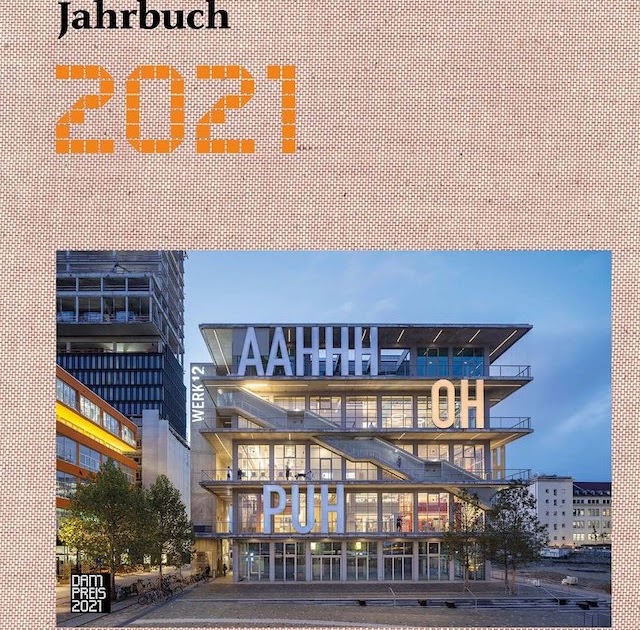German Architecture Annual 2021
German Architecture Annual 2021Yorck Förster, Christina Gräwe, Peter Cachola Schmal (Editors)DOM Publishers, YearHardcover | 9 x 11-2/4 inches | 256 pages | 350 illustrations | German/English | ISBN: 9783869227740 | 38.00€PUBLISHER'S DESCRIPTION:The German Architectural Annual, edited by the German Architecture Museum (DAM), has been documenting contemporary architectural projects in Germany for the past 40 years. This year´s edition of the annual presents the shortlist of 25 buildings selected by the jury for the 2021 DAM Preis for Architecture in Germany. The building reviews, written by architectural critics, along with large-format photographs, provide a deep insight into those works.REFERRAL LINKS: dDAB COMMENTARY:At the beginning of this year the Deutsches Architekturmuseum (DAM) awarded the 2021 DAM Preis for Architecture in Germany to MVRDV and N-V-O Nuyken von Oefele Architekten for WERK12, a five-story mixed-use building near Munich's Ost station that is part of the larger Werksviertel district. Fans of MVRDV, like me, no doubt felt the five-story mixed-use building wrapped in terraces and stairs looked familiar, recalling another building in Germany by the Dutch firm: the Netherlands Pavilion at the 2000 World Expo in Hannover. In the pages of this book devoted to the award, the editors admit as much too, writing that "MVRDV have not only drawn on their illustrious early period" around Expo 2000, "they have also confirmed themselves once again as visionary prophets." No surprise that the jury selected the building, which was completed in October 2019, unanimously.Documentation of WERK12 through drawings, photographs, and words comprises just eight pages in the 256-page book. This leaves plenty more pages for six-to-eight-page documentations of the three finalists (Wohnregal in Berlin by FAR frohn & rojas; Building-integrated roof greenhouse and administration building in Oberhausen by KUEHN MALVEZZI; Ernst Busch Academy of Dramatic Arts in Berlin by O&O Baukunst), the seventeen shortlisted projects (out of 200 nominations and 100 projects on the longlist), and the four shortlisted "export" projects outside Germany. The book also has room for an essay on the National Garden Show (BUGA), an interview with Wolfgang Kessling of Transsolar, a preface by the editors and JUNG, which co-sponsors the award with DAM, and a 25-page appendix on the DAM Preis and other DAM efforts.One of the most illuminating parts of the book is the editorial preface, which is tucked between the presentation of the top-four projects at the start of the book and the BUGA essay. In it, the editors explain the exceptional nature of the latest annual competition, which began right when COVID-19 sent the world into lockdown. DAM, like others, managed by handling things virtually, with the jury holding a lengthy online meeting to agree on 26 candidates (one was apparently dropped between then and publication). The determination of the finalists happened in person, and with just four buildings, all in Germany, the jury was able visit all of the finalists to determine the DAM Preis winner. A photograph captures some of the jury and the winning architects on the fourth-floor terrace of WERK12.Like those nominated to the DAM Preise, the projects in German Architecture Annual 2021 are not limited in terms of typology, but clearly they are limited to projects in Germany by any architect and projects outside of Germany that were designed by German architecture firms. This gives the book an obvious dose of national pride, as well as a little bit of a boost for DAM, which organizes the award but also uses the book to recap its other efforts over the last year. Combined with previous years, the annual books on architecture in Germany and beyond give a good sense of what is being produced and what trends are taking place (the trends are all over the place in 2021). That DAM continues with the book is noteworthy, as I'm pretty sure other organizations (e.g., AIA and RIBA) that used to produced "architecture annuals" no longer do so. That this one comes in a handsome package, with high-quality printing inside a linen hardcover, makes it that much harder for fans of German architecture to resist. SPREADS:

Hardcover | 9 x 11-2/4 inches | 256 pages | 350 illustrations | German/English | ISBN: 9783869227740 | 38.00€
PUBLISHER'S DESCRIPTION:
REFERRAL LINKS:
SPREADS:









